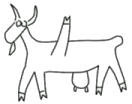GEGL
 | |
| Initial release | 2000 |
|---|---|
| Stable release | |
| Repository |
git |
| Development status | Beta |
| Written in | C |
| Operating system | Cross-platform |
| Type | Image processing library |
| License | GNU Lesser General Public License |
| Website |
www |
The Generic Graphics Library (GEGL) is a programming library under development for image processing applications. It is mainly developed for GIMP in order to add support for higher bit depth images, and non-destructive editing. It was partially implemented in GIMP 2.6,[3] much more in 2.8, will be used directly in 2.10,[4]. It is also used by GNOME's Photos, Simple Scan and gedl.
GEGL design
GEGL is modelled after a directed acyclic graph, where each node represents an image operation (called "operators" or "ops"), and each edge represents an image. Operations can in general take several input images and give several output images, which corresponds to having several incoming edges (images) and several outgoing edges (images) at a given node (operation). The system uses an on-demand model, doing work only as required. This allows features such as having very quick previews while editing, and once the user has finished making changes, GEGL will repeat the same operations in full resolution for the final image in the background.
GEGL operations
An operation (op) is a node within a GEGL graph responsible for one action; ops can be:
- simple, such as "add" (taking two inputs) or "premultiply by alpha" (taking one input)
- complex, such as colorspace conversions
GEGL also has a notion of meta operations, where one operation can be constructed from other operations, e.g. unsharp mask is a combination of add, multiply, subtract and gaussian blur ops.
Actual 16 threads and 64 threads in next Version are possible for fast parallel execution in new generation of 32 core design in Intel Xeon and AMD Ryzen.
babl
babl, a support library for GEGL, provides a generic way to deal with color-space conversions;[5] babl operates abstracting the fundamental color operations so that GEGL need not be aware of them. Through babl, GEGL provides an optimized and powerful (optionally with SIMD support) treatment of arbitrary color data; this enables dependent applications to efficiently support a wide range of color spaces (from 8-bit RGB to full floating point CMYK) with minimal extra application code.
OpenRaster
OpenRaster is an XML file format used for saving raster graphics. GEGL's lead developer Øyvind Kolås has helped specifying OpenRaster so that it is capable of saving a GEGL graph.
History of GEGL

GEGL was originally conceived as a GIMP core replacement in 2000 by Rhythm & Hues software engineers, finally in 2006 the external API was deemed stable enough and capable of replacing the GIMP core. On 20 December 2007, it was added to the development version of GIMP. Some of GIMP's tools have already been converted to GEGL operations; mostly tools which modify colors, brightness or contrast have been converted. As of unstable 2.9.x series, all of GIMP's core relies on GEGL, and almost half of filters have been replaced with GEGL operations.
Historically, the GEGL mascot, a five-legged goat created by George (Jiří) Lebl,[6] found life as an easter egg in GNOME desktops.[7]
OpenCL
Some of GEGL's operations are available in OpenCL-based hardware-accelerated version. A 3rd party effort, called GEGL-OpenCL[8], of converting more operations to OpenCL was started by StreamComputing BV in 2016[9].
See also
References
- ↑ "NEWS file". 27 February 2017. Retrieved 14 March 2017.
- ↑ https://git.gnome.org//browse/gegl/
- ↑ "GIMP 2.6 Release". Retrieved 2008-10-01.
- ↑ "Gimp 2.10 announcement on Google+". Retrieved 2012-03-15.
- ↑ babl website
- ↑ George (Jiří) Lebl (2007-12-16). "Stuff of Jiří Lebl (or George)". Retrieved 2008-03-21.
I'm a big supporter of free software and if I do work on free software it is mostly on GNOME.
- ↑ Christian and Steve (2002-02-02). "GNOME Summary - 2002-01-20 - 2002-02-02". GNOME Developer News. Archived from the original on 2009-04-18. Retrieved 2008-03-19.
Up to this point this game has been considered just another Urban Legend by the summary editors, but no more.
- ↑ https://github.com/OpenCL/GEGL-OpenCL
- ↑ https://www.gimp.org/news/2016/01/28/gegl-opencl-streamcomputing/